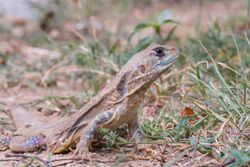Biology:Common butterfly lizard
| Common butterfly lizard | |
|---|---|

| |
| Scientific classification | |
| Domain: | Eukaryota |
| Kingdom: | Animalia |
| Phylum: | Chordata |
| Class: | Reptilia |
| Order: | Squamata |
| Suborder: | Iguania |
| Family: | Agamidae |
| Genus: | Leiolepis |
| Species: | L. belliana
|
| Binomial name | |
| Leiolepis belliana (Hardwicke & Gray, 1827)[2]
| |
| Synonyms[3] | |
| |
The common butterfly lizard (Leiolepis belliana), or simply the butterfly lizard, is a widespread species of lizard in the family Agamidae. The species is native to Asia.
Etymology
The specific name, belliana, is in honor of English zoologist Thomas Bell.[4]
Geographic range
L. belliana can be found in the forests of Cambodia, Indonesia, Malaysia, Myanmar, Thailand, and Vietnam.[2]
Description
L. belliana is known for the beautiful patterns on its back and sides. It has yellow spots on its back, and small orange and black lines on its sides.[citation needed]
Habitat
L. belliana lives on land that has been prepared for agricultural uses, as well as open sandy land along the coasts.[citation needed]
Ecology
Reproduction
L. belliana is monogamous, with a single adult pair inhabiting the same burrow, where 3-8 eggs are laid during hot, dry weather. This species also exhibits parental care of neonates, with neonates sharing their parents' burrow for a few months before digging their own burrow nearby.[5]
Diet
The butterfly lizard feeds on vegetation, crabs, grasshoppers, beetle larvae, butterflies, and other insects.[5]
Habitat
L. belliana digs and lives in a burrow ca. 30 cm (12 in) deep and 70 cm (28 in) long, to which it returns before dark, and uses its flattened body to seal the entrance to protect it from nocturnal predators. These burrows are also used during reproduction and as refuge from weather and fires.[6]
Invasive species in Florida
The Miami population of L. belliana originated from a tropical fish dealer, and the population was already well established in 1992. L. belliana is readily available in the pet trade, and reptile collectors are probably not exploiting the Miami population because this species is located on private properties in a residential area, difficult to catch, and not worth much as individuals typically wholesale for $3.50–5.50 each. The ecological impacts of L. belliana on native species in Florida are unknown.[6]
References
- ↑ Grismer L, Quah E, Neang T, Cota M, Lwin K (2019). "Leiolepis belliana". The IUCN Red List of Threatened Species 2019:e.T99930769A99931106. https://www.iucnredlist.org/species/99930769/99931106. Downloaded on 20 December 2020.
- ↑ 2.0 2.1 Species Leiolepis belliana at The Reptile Database www.reptile-database.org.
- ↑ Boulenger GA (1890). The Fauna of British India, Including Ceylon and Burma. Reptilia and Batrachia. London: Secretary of State for India in Council. (Taylor and Francis, printers). xviii + 541 pp. (Leiolepis belliana, pp. 156-157).
- ↑ Beolens B, Watkins M, Grayson M (2011). The Eponym Dictionary of Reptiles. Baltimore: Johns Hopkins University Press. xiii + 296 pp. ISBN:978-1-4214-0135-5. (Leiolepis belliana, p. 22).
- ↑ 5.0 5.1 "Nonnatives - Butterfly Lizard" (in en). http://myfwc.com/wildlifehabitats/nonnatives/reptiles/butterfly-lizard/.
- ↑ 6.0 6.1 Enge, Kevin; Krysko, Kenneth (2005-01-01). "A new non-native lizard in Florida, the butterfly lizard, Leiolepis belliana (Sauria: Agamidae)". Florida Scientist 68: 247–249. https://www.researchgate.net/publication/267333731.
Further reading
- Hardwicke T, Gray JE (1827). "A Synopsis of the Species of Saurian Reptiles, collected in India by Major-General Hardwicke". Zoological Journal [London] 3: 213–229. (Uromastix belliana, new species, p. 220).
- Smith MA (1935). The Fauna of British India, Including Ceylon and Burma. Reptilia and Amphibia. Vol. II.—Sauria. London: Secretary of State for India in Council. (Taylor and Francis, printers). xiii + 440 pp. + Plate I + 2 maps. (Leiolepis belliana, pp. 238–240, Figure 61).
Gallery
External links
Wikidata ☰ Q916925 entry
 |




